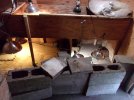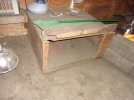Hello all, I am new to the forum and have really enjoyed reading through the discussions. I have noted the recommendation for Sulcata enclosures of a heat basking light (incandescent), in addition to a CHE on a thermostat, plus an appropriate UVB light and an LED or fluorescent light to brighten the enclosure. Some also suggest a floor heating element such as a Kane heating pad. I am curious why the incandescent light in addition to the CHE. Could the CHE be used to create the hot spot in the upper 90's and also create an ambient temperature in the 80's in other areas of the enclosure while relying on the UVB to provide the lighting and UV needs. I would assume the CHE would heat the enclosure more efficiently than the incandescent and the heating pad may be more efficient than both. That also raised the question if torts have a preference to warm themselves by basking in a warm light or sitting on a warm surface?
Also noted was the use of an oil-filled radiant heater. What is the minimal enclosure size to safely use of this type of heater? It seems this could be an efficient means of heating a closed top enclosure.
My last question is regarding substrate. I see cypress mulch noted frequently as an appropriate substrate. Arguably, cypress may not be the best environmental choice depending where and how it is harvested. In some areas over harvesting has dramatically changed the wetland habitat in areas of Louisiana and other coastal areas. Is there a preference of cypress over hardwood mulch for substrate?
Thank you
Randy
Also noted was the use of an oil-filled radiant heater. What is the minimal enclosure size to safely use of this type of heater? It seems this could be an efficient means of heating a closed top enclosure.
My last question is regarding substrate. I see cypress mulch noted frequently as an appropriate substrate. Arguably, cypress may not be the best environmental choice depending where and how it is harvested. In some areas over harvesting has dramatically changed the wetland habitat in areas of Louisiana and other coastal areas. Is there a preference of cypress over hardwood mulch for substrate?
Thank you
Randy

